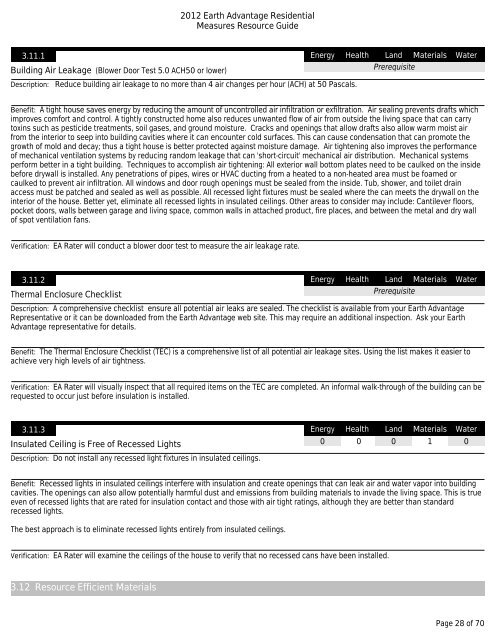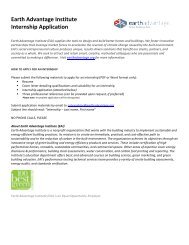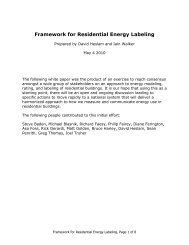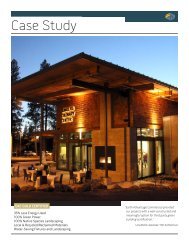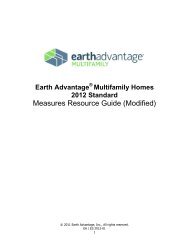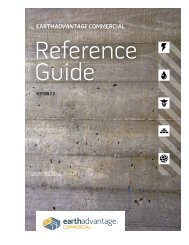EA New Homes Measures Guide - Earth Advantage
EA New Homes Measures Guide - Earth Advantage
EA New Homes Measures Guide - Earth Advantage
You also want an ePaper? Increase the reach of your titles
YUMPU automatically turns print PDFs into web optimized ePapers that Google loves.
2012 <strong>Earth</strong> <strong>Advantage</strong> Residential<br />
<strong>Measures</strong> Resource <strong>Guide</strong><br />
3.11.1<br />
Energy Health<br />
Building Air Leakage (Blower Door Test 5.0 ACH50 or lower)<br />
Description: Reduce building air leakage to no more than 4 air changes per hour (ACH) at 50 Pascals.<br />
Land Materials<br />
Prerequisite<br />
Water<br />
Benefit: A tight house saves energy by reducing the amount of uncontrolled air infiltration or exfiltration. Air sealing prevents drafts which<br />
improves comfort and control. A tightly constructed home also reduces unwanted flow of air from outside the living space that can carry<br />
toxins such as pesticide treatments, soil gases, and ground moisture. Cracks and openings that allow drafts also allow warm moist air<br />
from the interior to seep into building cavities where it can encounter cold surfaces. This can cause condensation that can promote the<br />
growth of mold and decay; thus a tight house is better protected against moisture damage. Air tightening also improves the performance<br />
of mechanical ventilation systems by reducing random leakage that can 'short-circuit' mechanical air distribution. Mechanical systems<br />
perform better in a tight building. Techniques to accomplish air tightening: All exterior wall bottom plates need to be caulked on the inside<br />
before drywall is installed. Any penetrations of pipes, wires or HVAC ducting from a heated to a non-heated area must be foamed or<br />
caulked to prevent air infiltration. All windows and door rough openings must be sealed from the inside. Tub, shower, and toilet drain<br />
access must be patched and sealed as well as possible. All recessed light fixtures must be sealed where the can meets the drywall on the<br />
interior of the house. Better yet, eliminate all recessed lights in insulated ceilings. Other areas to consider may include: Cantilever floors,<br />
pocket doors, walls between garage and living space, common walls in attached product, fire places, and between the metal and dry wall<br />
of spot ventilation fans.<br />
Verification: <strong>EA</strong> Rater will conduct a blower door test to measure the air leakage rate.<br />
3.11.2<br />
Thermal Enclosure Checklist<br />
Energy<br />
Health Land Materials<br />
Prerequisite<br />
Description: A comprehensive checklist ensure all potential air leaks are sealed. The checklist is available from your <strong>Earth</strong> <strong>Advantage</strong><br />
Representative or it can be downloaded from the <strong>Earth</strong> <strong>Advantage</strong> web site. This may require an additional inspection. Ask your <strong>Earth</strong><br />
<strong>Advantage</strong> representative for details.<br />
Water<br />
Benefit: The Thermal Enclosure Checklist (TEC) is a comprehensive list of all potential air leakage sites. Using the list makes it easier to<br />
achieve very high levels of air tightness.<br />
Verification: <strong>EA</strong> Rater will visually inspect that all required items on the TEC are completed. An informal walk-through of the building can be<br />
requested to occur just before insulation is installed.<br />
3.11.3<br />
Insulated Ceiling is Free of Recessed Lights<br />
Description: Do not install any recessed light fixtures in insulated ceilings.<br />
Energy Health Land Materials Water<br />
0 0 0 1 0<br />
Benefit: Recessed lights in insulated ceilings interfere with insulation and create openings that can leak air and water vapor into building<br />
cavities. The openings can also allow potentially harmful dust and emissions from building materials to invade the living space. This is true<br />
even of recessed lights that are rated for insulation contact and those with air tight ratings, although they are better than standard<br />
recessed lights. <br />
<br />
The best approach is to eliminate recessed lights entirely from insulated ceilings.<br />
Verification: <strong>EA</strong> Rater will examine the ceilings of the house to verify that no recessed cans have been installed.<br />
3.12 Resource Efficient Materials<br />
Page 28 of 70


